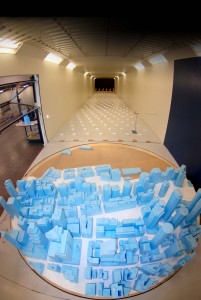News
Why our wind tunnels are so large
 Visitors to CPP’s facilities are often surprised to discover just how big our wind tunnels are in person. When asked why they’re so large, our response is always the same: Because we can’t make them any smaller.
Visitors to CPP’s facilities are often surprised to discover just how big our wind tunnels are in person. When asked why they’re so large, our response is always the same: Because we can’t make them any smaller.
In order to measure how pressures change across a surface, our test model must be large enough to accommodate all of the pressure taps that take those measurements. This requirement establishes a minimum size for model scale that’s driven by how many pressure taps are required for adequate measurements. If we choose a model that’s too small, we can’t fully resolve the distribution of pressures on a roof or a solar panel.
On the other hand, the larger the model, the larger the wind tunnel needed to accurately simulate the right wind conditions (Taken to the extreme, a full scale wind tunnel is needed to simulate a full-scale building.). Fabrication and instrumentation considerations also place a practical limit on just how large a model we can reasonably build and work with.
Taking these upper and lower limits into account, we usually build a test model that’s 250 to 500 times smaller than the real thing. But it doesn’t stop with the model itself. We also need to correctly simulate the nature of the wind approaching that model. That’s where the atmospheric boundary layer (ABL) capabilities of our wind tunnels come into play.
A low-rise suburban office complex in Las Vegas experiences very different kinds of wind than a high-rise condo on the Florida coast. So we place movable spires and cubes upwind of the test model to establish an approach flow that accurately mimics what the real building will see. Our technicians change these roughness elements as needed so that the flow reflects wind approaching from each direction of the compass.
It is this need for an accurate approach wind that ultimately determines how large our wind tunnels need to be. Just as wind in the real world develops as it moves over buildings and terrain, the wind in our tunnel needs to travel a certain distance for the roughness elements to build up the flow that will exhibit the right speed and turbulence properties by the time it reaches the test article.
As computational fluid dynamics (CFD) methods continue to evolve and improve, we’re still a long way from the critical technology that will make digital simulations as accurate as scale model wind tunnel testing.
All engineers have a tool chest from which they select the best tools for the job. It just happens to be the case that wind engineers need an especially large tool chest.
